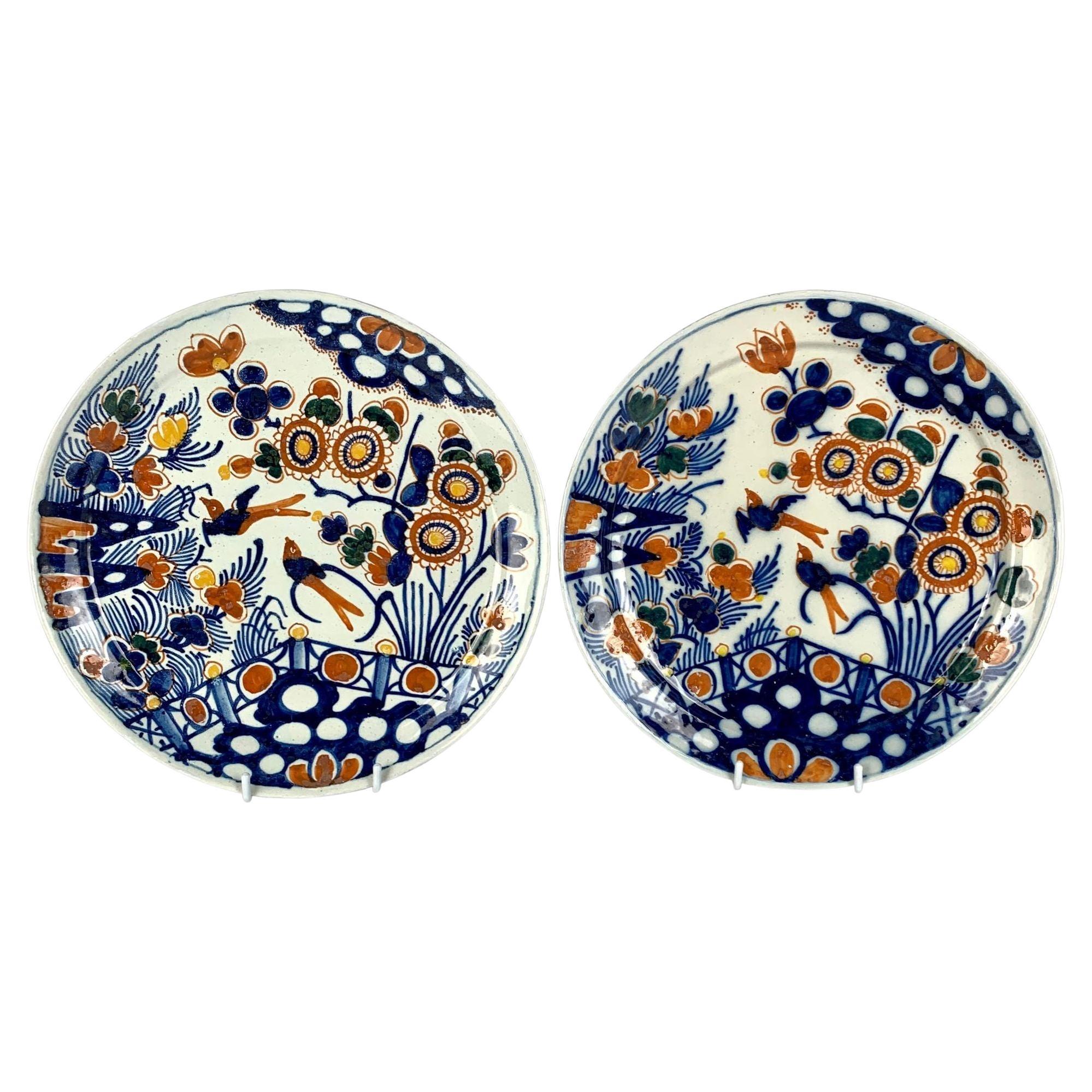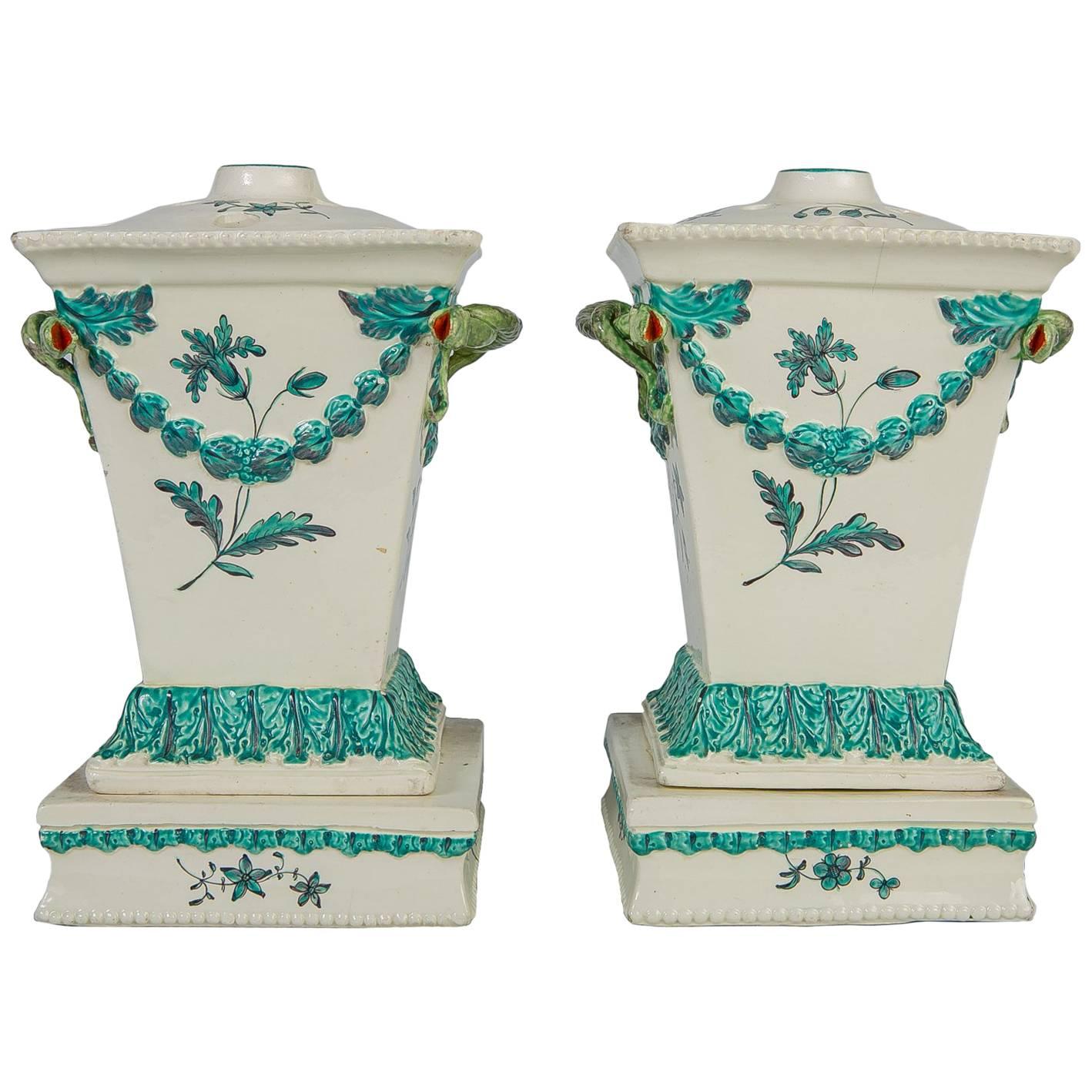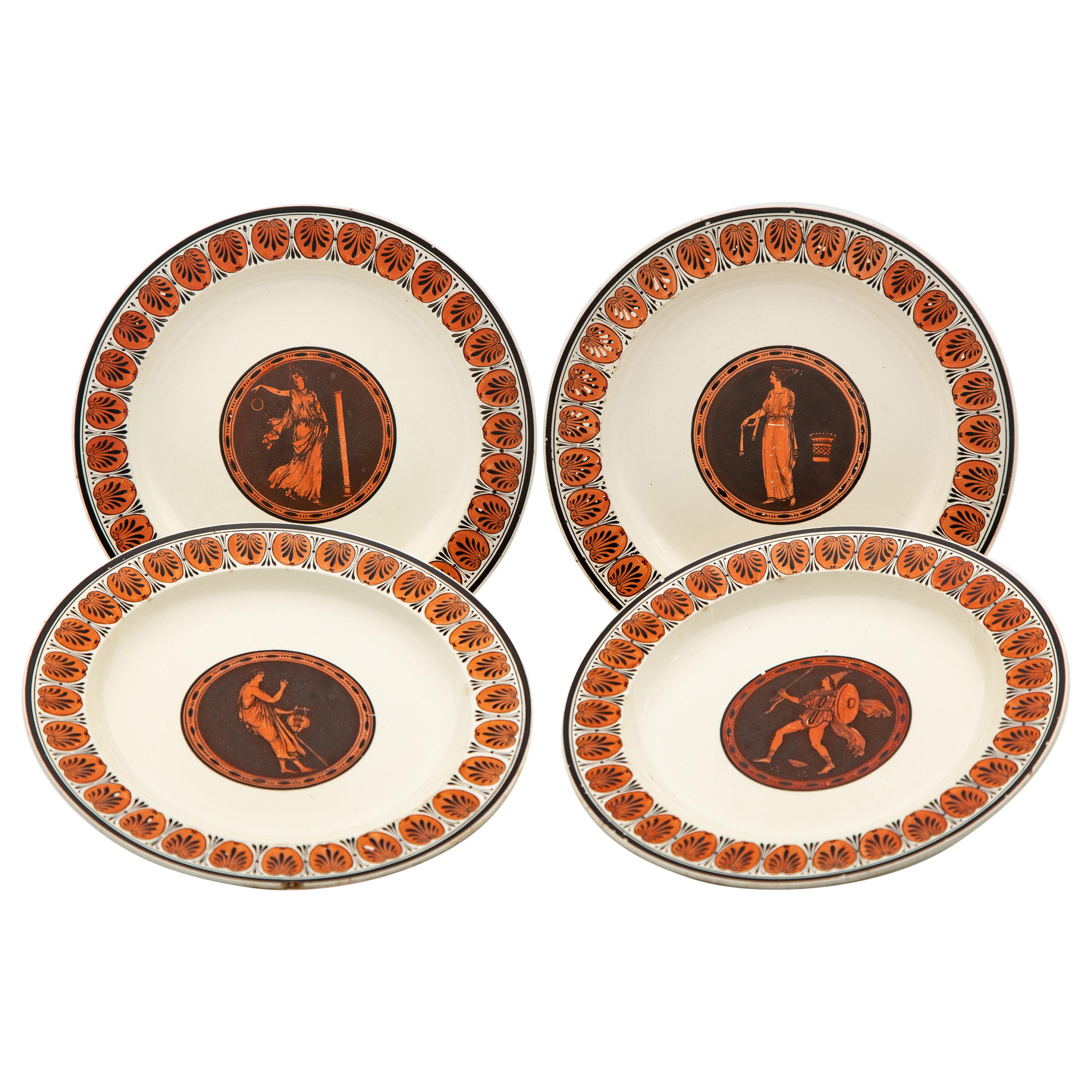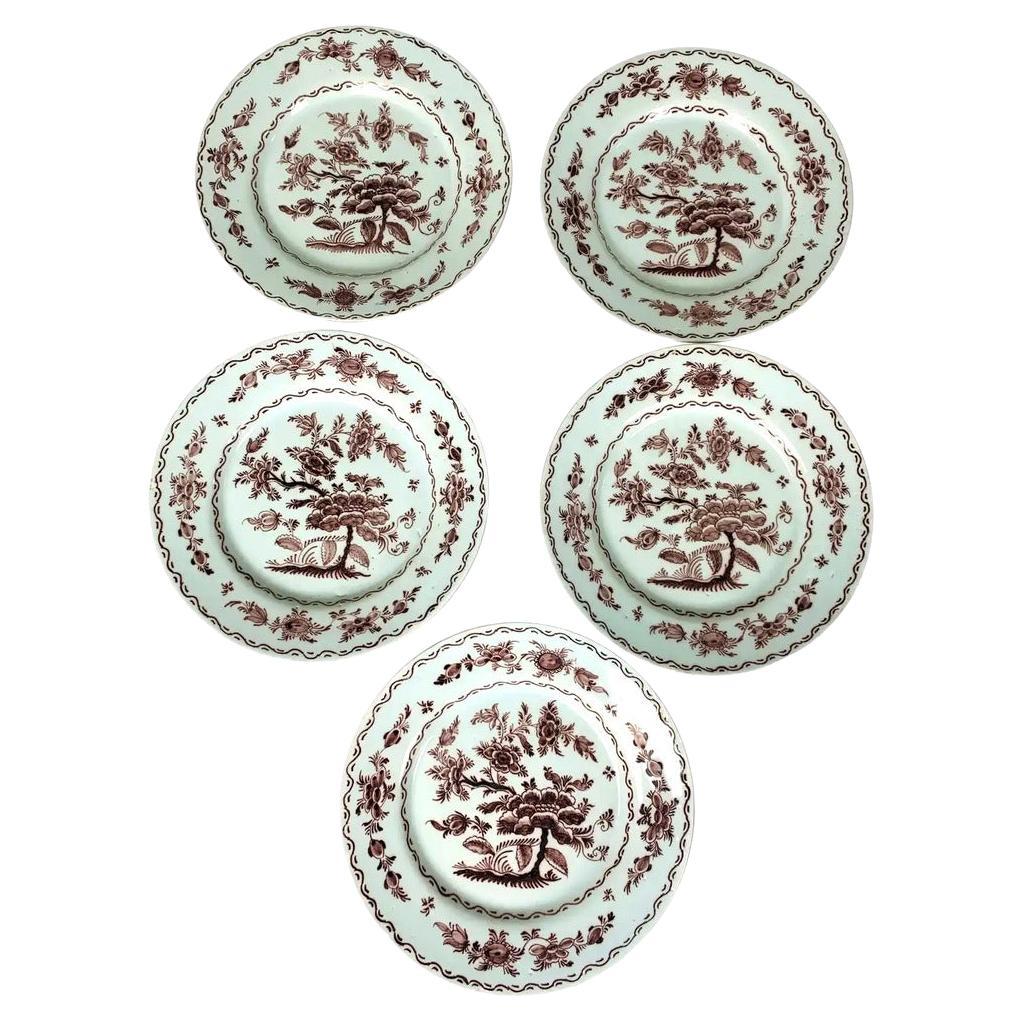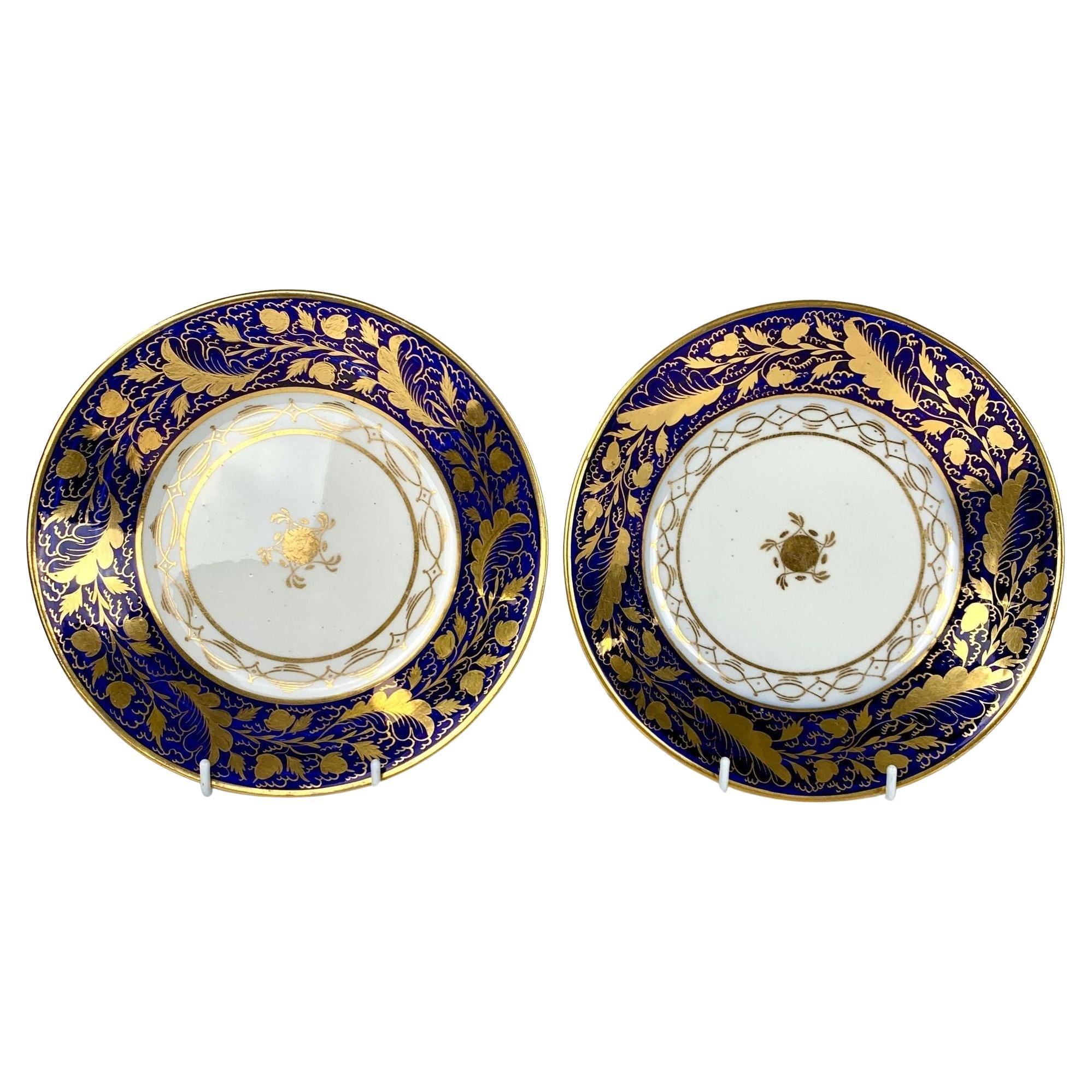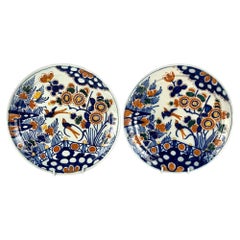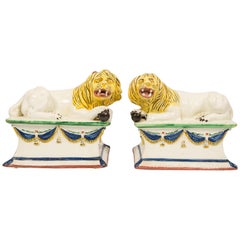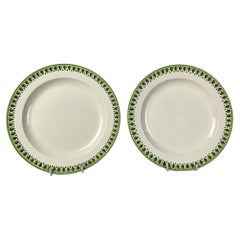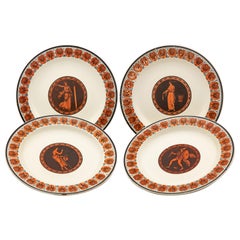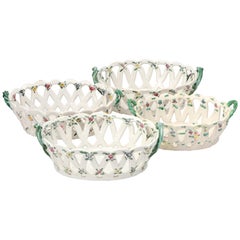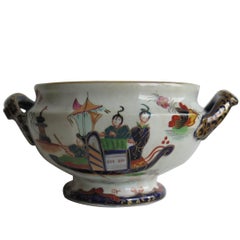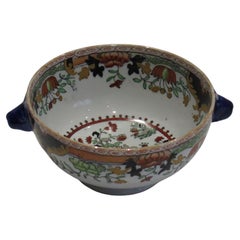Items Similar to Pair Meissen Style Creamware Dishes 18th Century England Hand Painted Circa 1780
Want more images or videos?
Request additional images or videos from the seller
1 of 7
Pair Meissen Style Creamware Dishes 18th Century England Hand Painted Circa 1780
About the Item
This is a pair of English creamware dishes from the 18th century, created around 1780. The plates display a lovely chinoiserie scene in the Meissen style, with women selecting accessories.
The two elegantly dressed women are in conversation. A young child holding a pinwheel looks up and points towards a group of chimes while an older boy stands close by. At the far right, we see another boy seated with a parrot on his arm.
Dimensions: 9.5 inches diameter
Condition: Excellent
Price: $520 for the pair
For an image and further discussion, see English Ceramic Circle Transactions, Volume 33, 2023, pp. 133-135, plate 60.
History of creamware:
Creamware, a type of earthenware with a light-colored body, was first created in the 1760s by Josiah Wedgwood, an English potter. Wedgwood marketed this new product as Queensware after Queen Charlotte ordered a set. Gradually, creamware became more popular, and other English potters began producing it as well. It soon replaced saltglaze stoneware as the preferred dinnerware for everyone except the high aristocracy, who likely used a service of Chinese export porcelain dishes.
- Dimensions:Height: 1 in (2.54 cm)Diameter: 9.5 in (24.13 cm)
- Sold As:Set of 2
- Style:Chinoiserie (Of the Period)
- Materials and Techniques:
- Place of Origin:
- Period:
- Date of Manufacture:circa 1780
- Condition:
- Seller Location:Katonah, NY
- Reference Number:Seller: 14/70231stDibs: LU8665805345
About the Seller
5.0
Recognized Seller
These prestigious sellers are industry leaders and represent the highest echelon for item quality and design.
Platinum Seller
Premium sellers with a 4.7+ rating and 24-hour response times
Established in 1962
1stDibs seller since 2009
476 sales on 1stDibs
Typical response time: 1 hour
- ShippingRetrieving quote...Shipping from: Katonah, NY
- Return Policy
Authenticity Guarantee
In the unlikely event there’s an issue with an item’s authenticity, contact us within 1 year for a full refund. DetailsMoney-Back Guarantee
If your item is not as described, is damaged in transit, or does not arrive, contact us within 7 days for a full refund. Details24-Hour Cancellation
You have a 24-hour grace period in which to reconsider your purchase, with no questions asked.Vetted Professional Sellers
Our world-class sellers must adhere to strict standards for service and quality, maintaining the integrity of our listings.Price-Match Guarantee
If you find that a seller listed the same item for a lower price elsewhere, we’ll match it.Trusted Global Delivery
Our best-in-class carrier network provides specialized shipping options worldwide, including custom delivery.More From This Seller
View AllPair Dutch Delft Hand Painted Imari Dishes 18th Century Circa 1780
Located in Katonah, NY
These Dutch pancake plates are adorned with a beautiful hand-painted scene in bold Imari colors of cobalt blue and iron red, enhanced by forest green and bright yellow, which replace...
Category
Antique Late 18th Century Dutch Rococo Delft and Faience
Materials
Delft
Pair 18th Century French Creamware Lions Hand Painted Circa 1790
Located in Katonah, NY
This rare and charming pair of 18th-century French creamware lions was made circa 1790.
Each lion reclines atop a tall rectangular base decorated with rich cobalt-blue swags, bright yellow tassels, and vivid green trim.
The forms are bold and expressive. The lions' open mouths are painted in soft pink, and their manes are rendered in vibrant yellow and lined with dark brown, lending them an animated, almost theatrical presence.
The lions rest on what appear to be stylized, draped cushions, adding a sense of comfort and reality.
Their wide-eyed expressions and exaggerated features give the pair a whimsical character that blends elegance with humor—a hallmark of late 18th-century French design.
Unmarked but unmistakably French in style, these figures make a striking decorative statement. Whether placed on a mantel or console, they command attention and offer a playful counterpoint to more serious classical forms.
Dimensions: 6.5 inches tall x 6.75 inches long x 4.5 inches wide
Condition: Excellent
Price: $2,300
Decoration: Painted in yellow, cobalt, green, pink, and brown with molded drapery and tassel detail
Material: Creamware pottery
Style: French Neoclassical with Folk Art elements
Origin: France
Date: Circa 1790
Key Features
- Rare pair of large 18th-century creamware lion figures
- Expressive hand-painted decoration with bold color contrasts
- Tall bases decorated with molded and painted swags and tassels
- French origin, circa 1790
- Whimsical and animated expressions add charm and visual interest
Background of creamware
Creamware is the name given to a type of earthenware pottery initially made from white clays from Dorset and Devonshire combined with an amount of calcined flint.
Creamware was first produced in England sometime before 1740. Foremost among the pioneers of creamware in the Staffordshire Potteries was Thomas Whieldon. The young Josiah Wedgwood partnered with Thomas Whieldon from 1754 to 1759. When Wedgwood left to set up his own business, he immediately directed his efforts to developing creamware.
Around the same time, in the mid-18th century, French potters developed their creamware known in France as "Faience Fine...
Category
Antique Late 18th Century French Neoclassical Animal Sculptures
Materials
Creamware
Pair Wedgwood Creamware Dishes England Circa 1810
By Wedgwood
Located in Katonah, NY
Made by Wedgwood in England circa 1810, this pair of creamware dishes features a neoclassical border decorated with a band of green acanthus leaves separated by black darts.
The bord...
Category
Antique Early 19th Century English Neoclassical Decorative Dishes and Vi...
Materials
Creamware
Pair Creamware Vases 18th Century English with Turquoise Trim Circa 1780
By Neale & Co.
Located in Katonah, NY
WHY WE LOVE IT: One of our absolute favorites!
A pair of 18th-century creamware flower holders complete with stands and covers made in England by Neale & Co. was one of the finest 18th century English potteries. The entire composition is classically elegant. The flower holders are decorated with turquoise swags and delicately painted flowers. The tops are pierced for flower stems. The handles are made in a pair of entwined snakes painted in turquoise with bright red mouths. This flower holder could be used with the tops for individual stems or without the tops for a bouquet. All parts of the set have survived and remained together for the past 200 years.
History of Creamware:
Creamware is the name given to a type of earthenware pottery made from cream-colored clays from Dorset and Devonshire combined with calcined flint.
Creamware was first produced in England sometime before 1740. Foremost of the pioneers of creamware in the Staffordshire Potteries was Thomas Whieldon. He produced a wide variety of creamware. The young Josiah Wedgwood was in partnership with Thomas Whieldon from 1754-1759. When Wedgwood left to set up his own business, he immediately directed his efforts to develop creamware. Many of the Staffordshire Potteries, especially Neale & Co., learned from Whieldon and Wedgwood and developed their own excellent creamware products.
Dated: 1795 to 1810 Hanley Staffordshire...
Category
Antique Late 18th Century English Neoclassical Vases
Materials
Creamware
Whieldon Creamware Tortoiseshell Plate 18th Century England, Circa 1765
By Thomas Whieldon Pottery
Located in Katonah, NY
This is a mid-18th-century creamware dish with exquisite tortoiseshell decoration.
Made in England circa 1765, the plate is decorated in brown, green, and gold hues.
The tortoiseshell decoration, also known as Whieldon ware...
Category
Antique Mid-18th Century English Decorative Dishes and Vide-Poche
Materials
Creamware
18th Century Wedgwood Creamware Bowl with English Strapwork Design Circa 1780
By Wedgwood
Located in Katonah, NY
This delicate 18th-century Wedgwood creamware bowl features a hand-painted songbird at its center.
It is a masterpiece of craftsmanship.
The bowl is made from fine, pale, cream-color...
Category
Antique Late 18th Century English Decorative Dishes and Vide-Poche
Materials
Creamware
You May Also Like
Early Wedgwood Neoclassical Creamware Dessert Dishes Made circa 1780
By Wedgwood
Located in Fort Lauderdale, FL
A set of four early Wedgwood creamware Neoclassical dessert dishes made circa 1780.
Sir William Hamilton’s Collection of Etruscan, Greek and Roman an...
Category
Antique Late 18th Century English Neoclassical Ceramics
Materials
Creamware
Two Pairs of Italian Maiolica Baskets, circa 1780
By Antonio Ferretti
Located in Milano, IT
Two pairs of maiolica baskets
Antonio Ferretti Manufacture
Lodi, circa 1770-1790
Maiolica polychrome decorated “a piccolo fuoco” (third fire).
Measures: A) Height 3.54 x 6.69 x 9.84 in (9 x 17 x 25 cm);
B) Height 3.93 x 7.48 x 11.02 in (10 x 19 x 28 cm).
Total weight 4.85 lb (2.200 kg)
State of conservation:
A) One of the smaller baskets has some areas of restoration, the other slight chipping from use;
B) One of the larger baskets is intact and the other shows a clearly glued break.
The mold with which the baskets were forged simulates a wicker weave.
The two larger works have high, vertical walls, with branch-shaped handles penetrating the weave. The painted decorations, small polychrome flowers applied only externally, highlight the points where the weaves intersect.
The decision to leave the center of the basket devoid of decoration is highly unusual, but given the size and complexity of the shape, as well as the quality of the enamel, it is possible to hypothesize that it represents a precise choice in manufacturing or for a particular client.
The two smaller baskets have small, twisted handles and, on the outside, reproduce more decisively the characteristic wicker weave, obtained through thin molded lines. The interior exhibits a rich, typical decoration of naturalistic flowers: a bunch centered around a main flower and secondary stems accompanied by small “semis”. The exterior of these works is also adorned with small little flowers where the weaves intersect.
The size and morphological characteristics of the baskets confirm their attribution to the Lodi factory of Antonio Ferretti between 1770 and 1790, during its most successful period; by this point his original reworking of the "Strasbourg" decoration, known as "old Lodi", had achieved great fame even outside Italy.
This decorative choice represented a strong point of the Lodi factory, which established itself thanks to the vivid nature of the colors made possible by the introduction of a new technique perfected by Paul Hannong in Strasbourg and which Antonio Ferretti introduced in Italy. This production process, called “piccolo fuoco” (third fire), allowed the use of a greater number of colors than in the past; in particular, the purple of Cassius, a red made from gold chloride, was introduced. Its use allowed for many more tones and shades, from pink to purple.
The Ferretti family had started their maiolica manufacturing business in Lodi in 1725.
The forefather Simpliciano had started the business by purchasing an ancient furnace in 1725 and, indeed, we have evidence of the full activity of the furnaces from April of the same year (Novasconi-Ferrari-Corvi, 1964, p. 26 n. 4). Simpliciano had started a production of excellence also thanks to the ownership of clay quarries in Stradella, not far from Pavia. The production was so successful that in 1726 a decree of the Turin Chamber came to prohibit the importation of foreign ceramics, especially from Lodi, to protect internal production (G. Lise, La ceramica a Lodi, Lodi 1981, p. 59).
In its initial stages, the manufacture produced maolicas painted with the “a gran fuoco” (double fire) technique, often in turquoise monochrome, with ornamentation derived from compositional modules in vogue in Rouen in France. This was also thanks to the collaboration of painters like Giorgio Giacinto Rossetti, who placed his name on the best specimens next to the initials of the factory.
In 1748 Simpliciano made his will (Gelmini, 1995, p. 30) appointing his son Giuseppe Antonio (known as Antonio) as universal heir. After 1750, when Simpliciano passed away, Antonio was directly involved in the maiolica factory, increasing its fortunes and achieving a reputation on a European level. Particularly important was the aforementioned introduction in 1760 of the innovative “a piccolo fuoco” (third fire) processing, which, expanding the ornamental repertoire with Saxon-inspired floral themes, could commercially compete with the German porcelains that had one of its most renowned offerings in the naturalistic Deutsche Blumen. Antonio Ferretti understood and promoted this technique and this decoration, proposing it in a fresher and more corrective version, less linked to botanical tables...
Category
Antique 1770s Italian Neoclassical Ceramics
Materials
Maiolica
John Ridgway Ironstone Bowl Hand-Painted pattern, William 1Vth Circa 1835
By John Ridgways
Located in Lincoln, Lincolnshire
This is a highly decorative, ironstone, twin handled circular footed Bowl by John Ridgway, dating to the English William 1Vth period, circa 1835 .
The bowl has been carefully hand-painted in bold colorful enamels with a chinoiserie pattern of three oriental people travelling on a boat, pattern number 5057. It is also richly hand gilded.
John Ridgway operated at his father’s celebrated Cauldon Place works, Shelton, Hanley, England, between 1830-1856, producing some fine porcelain and stone China of excellent quality. His stone China earthenwares and ironstone wares are discussed on page 305 of Godden's Guide to Ironstone, Stone and Granite Wares written by Geoffrey Godden for the Antique Collectors Club.
This piece is fully marked to the base with an Imperial Stone China...
Category
Antique Mid-19th Century English Chinoiserie Decorative Bowls
Materials
Ironstone
Masons Ironstone Bowl in Peacock Peony & Rock hand painted Pattern, circa 1838
By Mason's Ironstone
Located in Lincoln, Lincolnshire
This is a twin boar handled open Bowl made by Mason's Ironstone in the rare Peacock, Peony and rock pattern, dating to the early / mid 19th century, circa 1835 to 1840..
Mason's bow...
Category
Antique Early 19th Century English Chinoiserie Decorative Bowls
Materials
Ironstone
18th Century Spanish or North African Faience Deep Bowl
Located in Chapel Hill, NC
A stunning Spanish or North African faience deep bowl. 18th century. Well cared for with various old rim repairs typical of the form. Red ware base. 15 1/4" diameter, 4" height.
We ...
Category
Antique 18th Century Ceramics
Materials
Ceramic
$695 Sale Price
42% Off
19th Century French Hand Painted Large Ceramic Bathroom Plate by Gien
By Gien
Located in Sofia, BG
19th century French hand made and hand painted large fine ceramic bathroom plate with a special soap place marked by GIEN. Very good condition with no restorations.
France, circa 1880.
Category
Antique Late 19th Century French Decorative Dishes and Vide-Poche
Materials
Ceramic
$429 Sale Price
30% Off
Recently Viewed
View AllMore Ways To Browse
18th Century Wedgwood
18th Century Creamware
Used Wedgwood China
Antique Meissen China
Antique Glass Dinnerware
Antique Wedgwood China
Surfline Chair
Susana Espinosa
Sven Jonson Facett
Sven Madsen Table
Svenskt Tenn Flora
Swan King Bed
Swedish Art Deco Burr Elm Table
Swedish Blanket Chest Flat Top
Swedish Bread Box
Swedish Flora Cabinet
Sweet Meat Box
Swimming Pool Fountain
